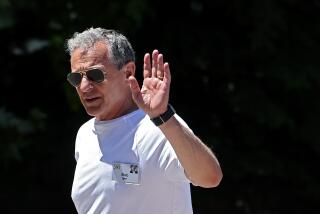CEO, Chairman Roles Increasingly Being Split
By divorcing the role of chairman and chief executive Wednesday, Walt Disney Co. is following an increasingly popular path.
Dozens of major companies have wrenched the title of chairman of the board away from their CEOs in the last three years as corporate accounting and market manipulation scandals have focused a spotlight on the way that both boardrooms and executive suites are run.
Shareholder advocates say this separation of power is pivotal in maintaining a balance between management and the people who own stock, especially big pension funds and other institutions.
“Institutional shareholders are definitely putting pressure on the corporate world to bifurcate these responsibilities,” said Jack Williams, a professor at Georgia State University in Atlanta.
Of course, it’s doubtful that Disney’s action will mollify the investment community. Many believe that Michael Eisner, who will lose his chairman title and remain CEO, should be ousted from the company altogether after an unprecedented 43% of shareholders Wednesday withheld votes for his reelection to the board.
What’s more, the man installed as Disney’s new chairman -- former U.S. Sen. George J. Mitchell -- failed to win 23% of the votes cast at the company annual meeting, also an unusually high number.
In general, though, corporate governance experts cite several advantages in keeping the chairman and chief executive jobs separate.
For one thing, by severing the two jobs, the CEO can stay focused on day-to-day operations. The chairman is then free to take the longer, strategic view -- suggesting moves that will better position the company in the future -- even if that causes some short-term tumult.
“That tension is what the chairman and CEO should confront on a regular basis,” Williams said. “Very few of us can keep focused on both missions. It’s human nature that whatever seems to be the most important at the time will demand most of your attention.”
The number of companies that divide these slots has been steadily rising, according to the Investor Responsibility Research Center, which studied 1,245 companies in the Standard & Poor’s 500, MidCap and SmallCap indexes. Of that number, 30% had separate chairmen and chief executives at the end of 2003, compared with just 25% in 2000.
However, only about 9% of those companies named chairmen who were truly independent, the group said.
The majority of the separate chairmen were either employees of the company, relatives of an employee, worked for institutions that received charitable contributions from the company or were involved in business transactions with the company -- all of which jeopardized their ability to be truly independent.
Such concerns are sure to dog Disney, with Mitchell’s law firm, Piper Rudnick, having received more than $2.1 million in fees and expenses from the entertainment giant since he joined its board.
In all, the Corporate Library estimates that about 10% of the 2,000 companies that it tracks have separate and independent chairmen. But several of those companies didn’t name the independent chairman voluntarily. Instead, independence was thrust upon them through bankruptcy reorganizations, such as the ones affecting Kmart Holding Corp. and US Airways.
Other companies with separate chairmen and CEOs include Chubb Group of Insurance Cos., Omnicom Group and Northwest Airlines Corp.
Nextel Communications Inc., for its part, says it separated the chairman and CEO positions “before it was trendy.”
“There is a tremendous benefit to independent thinking and diversity of ideas that’s best achieved by having these positions separate,” said Audrey Schaefer, senior director of corporate communications for Nextel. “It helps balance the decision making process.”
JDS Uniphase Corp., a San Jose technology company that separated its chairman and CEO positions in 2000, also believes the practice is beneficial.
“We did a study of best practices and one of the recommendations that we made to ourselves was that we separate the chief executive and chairman positions,” said Christopher Dewees, senior vice president and general counsel.
“Having an independent chairman allows a single leader, who is not part of the management staff, to drive the board agenda,” Dewees added. “That’s very important.”
The chairman decides what the board is going to consider during its regular meetings. If he’s also the CEO and there’s some operational issue that’s damaging or embarrassing, he can simply choose to avoid it.
“You have an example in your midst right now of having an entrenched CEO who is also the chairman setting the agenda,” Dewees said, referring to Eisner. “From a corporate governance standpoint, you have less potential for conflicts of interest when the positions are separate.”
Whether Mitchell and Eisner are the right men for these jobs, though, remains to be seen.
More to Read
Inside the business of entertainment
The Wide Shot brings you news, analysis and insights on everything from streaming wars to production — and what it all means for the future.
You may occasionally receive promotional content from the Los Angeles Times.










